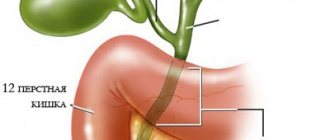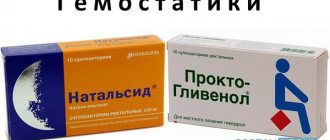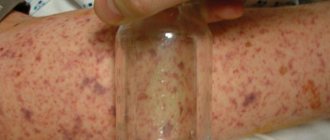Some of the most unpleasant symptoms of pathological conditions are vomiting bile and diarrhea. Many people experience these phenomena, which arise as a result of a number of processes in the body, provoked by temporary or pathological disorders. Nausea and vomiting of bile can significantly expand the range of possible diseases, so the presence of these signs requires immediate consultation with a doctor for an accurate diagnosis.
How does vomiting with bile manifest?
Vomiting is a natural result of nausea.
The exception is toxicosis during early pregnancy, when nausea comes on suddenly. Usually, the gag reflex significantly improves the patient's well-being. Vomiting bile is a little different. Liver secretions are detected in vomit if the patient vomits on an empty stomach. This is the result of a sharp contraction of the stomach muscles, which opens the sphincter into the duodenum. Often, vomiting with bile impurities appears after repeated emptying of the stomach, when there is nothing left to vomit. This happens after drinking alcohol.
If bile enters the stomach constantly, the gag reflex does not bring relief to the patient, but alleviates the condition until the next urge. Nausea does not completely disappear, since bile enzymes constantly irritate the gastric mucosa.
Bile gives vomit a specific yellow-green color. After the urge, the patient feels a persistent bitterness in the mouth. As a result of repeated vomiting, the plaque on the root of the tongue turns yellow-green. Associated symptoms include heartburn, in response to bile irritation of the esophageal mucosa, and unpleasant, foul-smelling belching.
Possible diseases
Gag reflexes should not be suppressed. In an adult, vomiting can occur in the morning and continue throughout the day, regardless of food or medication consumption. Vomiting bile in a child with a fever and diarrhea can also be caused by a concussion, which is often observed after a strong blow to the head. To determine the disease that provoked such symptoms, one must correctly recognize the nature of the symptoms. Diseases and conditions that are characterized by this condition:
Frequent vomiting occurs in the presence of liver pathologies.
- pancreatitis;
- cholecystitis;
- appendicitis;
- food infection;
- hepatitis;
- intestinal obstruction;
- infections;
- liver and stomach diseases;
- drug overdose.
Pancreatitis
The disease is characterized by acute, prolonged abdominal pain. Exacerbation occurs when eating fatty, spicy or fried foods. The color of the skin changes; in the area of the stomach and navel, the skin acquires a bluish tint. Main symptoms:
- vomiting food particles, then bile;
- heartburn;
- digestive disorders accompanied by fever and diarrhea;
- bloating;
- dyspnea;
- rapid weight loss;
- stomach and chest pain.
Cholecystitis
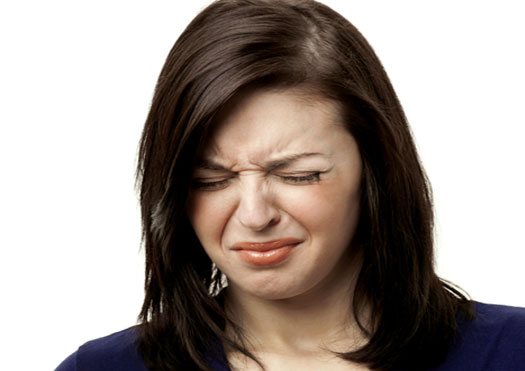
The disease is identified by cramping pain in the right hypochondrium and a bitter taste in the mouth. The patient vomits during the day, there is an increase in temperature and belching of gases. During an exacerbation, patients experience yellowing of the skin and eyes, and constant stomach upset after eating. The stool becomes pale in color with a gray tint. In an adult, an attack can be triggered by drinking alcohol or overusing medications.
Appendicitis
The pathology is equally observed in people of different ages. An exacerbation of the disease occurs suddenly, without any special symptoms. The frequency and intensity of manifestations depends on the age and gender of the patient, as well as the individual characteristics of the body. Main symptoms with sequential development:
- sudden sharp pain in the solar plexus area;
- vomiting with bile;
- fever;
- dyspepsia;
- general weakness;
- heat;
- cardiopalmus;
- sweating;
- difficulty manipulating the body.
Food infection
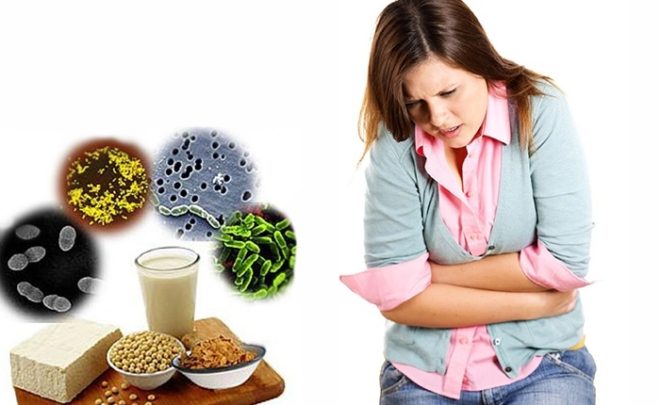
The condition is caused by bacteria and viruses entering the body with food, which provoke a number of disorders. An intestinal infection can manifest itself from 6 to 48 hours, the dangerous consequence of which is dehydration. This is caused by frequent vomiting and fluid loss, resulting in an imbalance of sodium and potassium in the body. Main features:
- stomach ache;
- sweating;
- weakness and apathy;
- nausea, unpleasant taste in the mouth;
- temperature increase;
- chills.
Hepatitis and its symptoms
Symptoms of the disease in adults are identical: yellow tint to the eyes and skin, nausea, nose and gum bleeding, rash on the body, dark urine and joint pain. The difference in women is possible uterine bleeding and increased menstrual flow. Hepatitis in children manifests itself in relatively the same way as in an adult, but most often the child gets hepatitis A, that is, jaundice. Symptoms:

A yellow tint to the skin and sclera of the eyes is characteristic of hepatitis A.
- nausea;
- vomit;
- decreased appetite;
- headache;
- increased body temperature;
- dry mouth;
- bowel disorders;
- gas formation.
Intestinal obstruction
Signs of the disease are sudden abdominal pain that occurs regardless of food intake or time of day. Cramping, immobilizing attacks that constrain the entire body. There is stool retention and gas, bloating and asymmetry of the abdomen. Frequent bowel movements below the obstruction are possible. Evacuations are profuse, uncontrollable, leading to severe weight loss. The attacks are repeated at intervals of 10-15 minutes, resulting in severe exhaustion of the body.
Infections caused by pathogenic microorganisms
Infectious diseases always progress against the background of weakened immunity and can take over the entire body. Viruses and bacteria enter the body in different ways, but have the same effect on the patient’s internal intestinal microflora. As a result, organs and systems malfunction and pathological processes occur. Almost all types of lesions have a common picture of manifestation:

The person feels constantly tired.
- general weakness;
- malaise;
- body aches;
- elevated temperature;
- joint pain and migraines;
- intestinal disorders;
- sleep disorders;
- cough;
- rashes on the body;
- vomited after eating.
Other causes of unpleasant symptoms
Vomiting of bile often occurs as a result of poisoning or ingestion of low-quality, expired products, which irritate the gastric mucosa and cause rejection. Migraines, constipation, painful menstrual cycles, overeating or severe stress, as well as excessive consumption of alcoholic beverages are common causes of vomiting. The prerequisites are an increase in temperature and abdominal pain, and a person begins to feel an unpleasant taste in the mouth. A dangerous situation is when a child vomits bile, since the previous factors are unlikely at a young age.
What to do if you vomit bile?
A single vomiting with bile impurities does not mean the development of pathology. More often this is a reaction to eating low-quality, stale or heavy foods. However, the symptom cannot be ignored. The patient should carefully listen to how he is feeling, drink more clean still water and temporarily limit food intake. Children should be fed as desired. This way the body will recover faster.
If you vomit bile several times, this is a reason to take urgent action. The patient should drink water frequently in small sips. Unpleasant sensations and nausea are eliminated by chamomile infusion or mint tea. They are drunk after cooling, in small portions. Rosehip decoction will also help. The drink will refresh, relieve attacks of nausea, and have a mild choleretic effect.
If vomiting does not stop throughout the day and is accompanied by other severe symptoms, you should consult a gastroenterologist. Signs of dangerous conditions:
- uncontrollable vomiting with bile;
- temperature increase;
- clouding of consciousness, dizziness;
- sharp cramps in the abdomen;
- signs of dehydration (dry and sagging skin, sunken eyes, lack of urination, dry mouth);
- icteric syndrome (yellowing of the sclera, mucous membranes, skin, hemorrhagic rash).
These symptoms may indicate serious poisoning, severe diseases of the internal organs, and the development of hepatic colic, which is fraught with painful shock. With such symptoms, the patient should not be left alone. It is necessary to take him to the hospital or call an ambulance.
In addition to sorbents, you should not take other medications before the doctor arrives - they can “blur” the clinical picture and complicate the correct diagnosis.
Vomiting with bile in children requires special attention. If the child vomits a second time, and there are bile impurities in the mass, you should urgently call a doctor at home or take the baby to the clinic. Vomiting for children is dangerous due to the rapid development of dehydration, which causes irreversible changes in the functions of internal organs.
Postcholecystectomy syndrome and causes of vomiting after removal of the gallbladder
Despite the fact that all complications after removal of the gallbladder are of a different nature, doctors, for convenience and ease of understanding, have united them under the general name - postcholecystectomy syndrome. Conventionally, its manifestation can be divided into two groups: complications that arose due to the operation itself, and those that the patient already had, but became more active after the operation. They manifest themselves as abdominal pain, nausea and vomiting, diarrhea, weakness and even jaundice. According to statistics, only in a small proportion of all these cases is the absence of the gallbladder itself, which is responsible for the accumulation of bile produced in the liver, to blame. Much more often the cause lies in diseases of the pancreas, duodenum and liver.
In general, regarding the range of likely factors causing vomiting after gallbladder removal, the list is as follows:
- sphincter of Oddi dysfunction;
- liver diseases;
- diseases of extrahepatic bile excretion pathways;
- pancreatic diseases;
- disruption of bile transit.
Looking like smooth muscle, the sphincter of Oddi is located in the major duodenal papilla, which, in turn, is localized on the inside of the descending region of the duodenum. The exits of the main pancreatic duct (from the pancreas) and the central bile duct are also located there. If there is difficulty in the work of this smooth muscle, it destabilizes the secretion of the pancreas through transformations that occur in the major duodenal papilla. All this leads to such ailments as mechanical jaundice and cholangitis, both of which can cause nausea and vomiting after removal of the gallbladder.
Causes of discomfort and discomfort in the anus
In 50% of patients who have undergone cholecystectomy, bile stagnation is significantly reduced within two years, as well as various degenerative phenomena in the liver. However, during the first six months after surgery, bile stagnation may increase due to activation of the sphincter of Oddi tone, localizing in the extrahepatic bile ducts. As for vomiting, after removal of the gallbladder it can be caused by serious liver dystrophy, which manifests itself in the form of fatty hepatosis in a third of those operated on.
If we talk about diseases of the extrahepatic biliary tract, then after removal of the gallbladder, the common bile duct increases in volume, which leads to corresponding disorders. This happens because before removal, the gallbladder served as a kind of reservoir that accumulated bile, whereas after its removal, the duct inevitably begins to take over the function of backup. As a result, the volume of this duct can increase 10 times.
If we talk about the reasons that are associated with the bile ducts and can cause vomiting, the list is as follows:
- Strictures in the bile duct (choledochus) are a consequence of its injury during surgery, or the installation of drainage after surgery. In addition to cholangitis and jaundice, symptoms of bile stagnation, expressed including through vomiting, can manifest themselves;
- Another cause of vomiting after removal of the gallbladder may be stones in the bile ducts. For subsequent treatment, it is important to distinguish the nature of their origin: either they formed after the operation, or during cholecystectomy the surgeon did not notice them and did not remove them. The second case is much more common, while the first is considered to be a consequence of stagnation of bile in the ducts due to the formation of scar tissue in the terminal part of the bile duct;
- sometimes there is the development of a long stump in the cystic duct, which increases in size all due to the same scar tissue in the terminal part of the bile duct. All this provokes a violation of the passage of bile, the formation of stones and the appearance of infection;
- An even more rare cause of pain and vomiting is a cyst located in the common bile duct. Most often it appears as an aneurysm with subsequent expansion of the walls of the common bile duct, but sometimes it appears as a diverticulum (protrusion) on the side wall of the duct;
- finally, one of the most severe consequences of removing the gallbladder is cholangitis, when due to an infection the ducts become inflamed, which is greatly facilitated by stagnation of bile. All this can also provoke vomiting.
The next possible cause of vomiting may be diseases of the pancreas, which can lead to cholelithiasis. As a rule, after cholecystectomy, patients note normalization of the functioning of this gland, but with a long and complicated course of gallstone disease, irreversible metamorphoses appear in it. Patients complain of symptoms such as abdominal pain (radiating to the back), itching of the skin, jaundice, constipation, diarrhea, nausea or vomiting.
What can cause a lump in the throat, causes and treatment
The last cause of vomiting after removal of the gallbladder, as already mentioned, may be a violation of the transit of bile along its paths. Due to the absence of a previous reservoir for accumulation, bile begins to be released uncontrollably directly into the intestines, interfering with absorption in it, the absorption of fats and the normal functioning of microflora. In addition, a violation is noted in the composition of the bile itself, which provokes an increased risk of stone formation. All together, this disrupts metabolism and metabolism in the small and large intestines, which then leads to enteritis, colitis, gastritis and duodenitis.
How to recover from vomiting
Nausea and vomiting debilitate the body, causing fluid loss and electrolyte imbalance. After the symptoms disappear, it is necessary to provide conditions for restoring the functioning of the gastrointestinal tract.
After vomiting, it is better to drink only liquids. The drinking regime is observed for 6 hours. Then they gradually begin to eat food. It should not irritate the gastrointestinal tract, stimulate gas formation and peristalsis. After vomiting, alcoholic and carbonated drinks, fatty, salty, sour, hard foods, fast food, and sweets are prohibited.
The patient should eat small meals up to 6 times a day for the next 3 days. The diet should contain:
- porridge in water with a small amount of butter;
- boiled vegetable soups without frying;
- low-fat mashed potatoes;
- egg white omelet;
- ground dishes made from boiled meat or products made from lean minced meat, steamed.
You can use berry jelly and bananas as enveloping foods. It is better to hold off on fruits and raw vegetables. Regular bread should be eaten dry.
First aid for vomiting bile
Before using various drugs and solutions, you need to establish symptoms. If you have severe stomach pain and weakness, you should call an ambulance. If there are no such symptoms, then you need to empty your stomach of food. Then drink a liter of warm water and rinse the stomach with a solution of soda or potassium permanganate:
- take 2-3 crystals of potassium permanganate for a small amount of water and dissolve the mixture in a liter of water;
- the liquid should be at room temperature, the finished solution has a pink tint;
- it is filtered through cheesecloth and taken.
If you have cholelithiasis, you cannot use potassium permanganate, just like if you have an ulcer.
Anti-vomiting medications
It is best to use activated charcoal for vomiting bile and diarrhea, but it should be taken only after gastric lavage. The tablets are kneaded well with a spoon and washed down with water. For 10 kg of weight take 1 tablet. Other sorbents can also be used.
If vomiting stops but symptoms remain
There is a type of vomiting that does not bring relief. This is not uncommon in the case of biliary vomitus. She talks about the development of diseases:
- stomach;
- duodenum;
- pancreas;
- liver.
Treatment of the provoking disease will allow you to completely eliminate the symptoms. It is impossible to make an accurate diagnosis based only on vomiting and symptoms. A comprehensive examination by a specialized doctor will be required.
Laboratory tests of blood and urine, hardware diagnostic procedures (ultrasound, MRI, X-ray examinations of the abdominal cavity) help to assess the condition of organs. Based on the confirmed diagnosis, treatment for the underlying problem is selected. After therapy, signs of nausea should completely disappear.
Diagnostics
For your information! Sometimes bitterness in the mouth appears without other symptoms, and after hygiene procedures it disappears and does not appear again.
Most likely, in this case, the reason was precisely overeating or excessive alcohol consumption.
The presence of bitterness throughout the day, which does not disappear after brushing your teeth and appears the next day, should be a reason to consult a doctor.
To begin with, you can go to your local physician and tell about all your symptoms.
In this case, it is important to remember what was eaten on the eve of vomiting, which caused nausea and, possibly, to indicate the nature of the vomit (solid, liquid, with bile).
If a person knows for sure that bitterness and vomiting are associated with exacerbation of diseases of the gastrointestinal tract, you can immediately contact a gastroenterologist.
You should know! During the examination, the doctor prescribes a number of standard tests:
- general blood test, urine test;
- coprogram;
- blood biochemistry;
- Ultrasound;
- FGDS;
- radiography.
If the internal organs are healthy and no diseases have been identified, the person is sent to a cardiologist.
He conducts a survey, prescribes an ECG and EEG to confirm or refute vegetative-vascular dystonia.
After this, you can visit an otorhinolaryngologist and dentist . It is quite possible that the bitterness in the mouth was always present, but the person noticed it only during vomiting and connected the two symptoms together.
It is worth noting! Diseases of the teeth and gums may also cause a bitter taste in the mouth.
What is the problem?
Vomiting, including with impurities of bile, often accompanies food and drug poisoning, alcohol intoxication, infection with viruses or pathogenic bacteria. The final diagnosis will be established on the basis of anamnesis, patient complaints, examination of urine, blood, and feces. Therapy consists of gastric lavage, prescribing sorbents, symptomatic drugs, antidotes (for poisoning), antibacterial or antiviral agents.
If vomiting with bile occurs in a pregnant woman, it is often said to be due to toxicosis. Drug treatment is not prescribed if a woman vomits less than 5 times a day and the general condition of her body is satisfactory. Antiemetic and detoxification drugs will be required for debilitating vomiting, when there is a risk of dehydration and exhaustion of the body. In case of severe toxicosis, temporary hospitalization is possible.
Liver diseases
Vomiting with the release of bile can accompany a number of liver pathologies. It often occurs in people who have undergone cholecystectomy. In them, bile enters the duodenum in a larger volume and, when the sphincter is weak, enters the stomach. The result of its irritating effect is strong vomiting. The risk increases if the patient neglects the doctor's dietary recommendations.
Vomit with bile is a symptom of inflammation of the gallbladder (cholecystitis), cholelithiasis, and the release of stones into the duct. In this case, surgery to remove the gallbladder is often prescribed. Pain in the right hypochondrium that accompanies vomiting, severe cramps, and darkening of the color of urine may indicate liver damage.
Repeated vomiting is possible with cancer. After the stomach is completely emptied, bile appears in the vomit. Such conditions are observed in progressive malignant diseases in the later stages of development. Vomiting is controlled with special medications. The symptom also occurs during radiation and chemotherapy.
Diseases of the upper gastrointestinal tract
Vomiting with bile often accompanies exacerbation of gastritis, when digestion of food is difficult, and bile continues to be secreted reflexively. The most commonly diagnosed cause is ulceration of the gastric mucosa. With the development of a peptic ulcer, the bile in the vomit is replaced by dark brown impurities, which signals gastric bleeding.
Repeated vomiting occurs with psychosomatic and neurological disorders. Sometimes it accompanies stressful conditions and psycho-emotional shocks. The symptom is treated with special drugs that normalize the transmission of nerve impulses in the brain, sedatives and neuropletics.
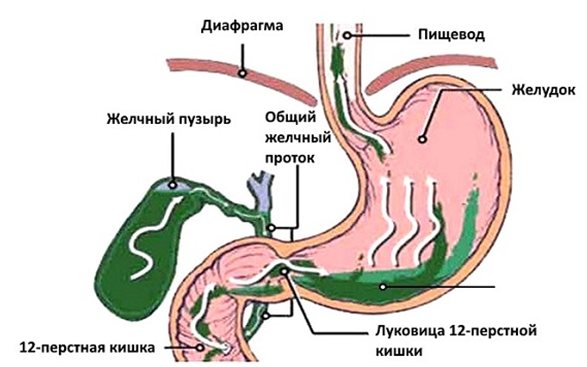
The release of bile during vomiting is observed during inflammation and ulcer of the duodenum, when its peristalsis is disrupted. Frequent vomiting with copious secretion of bile indicates small intestinal obstruction. Food cannot move along its natural path, and therefore the body sends a signal to remove it through the mouth.
Pancreatic diseases
Vomiting with bile inclusions almost always accompanies pancreatitis. Inflammation leads to nausea, bloating, and bowel dysfunction. If food enters the duodenum that the pancreas cannot digest, a gag reflex occurs. The bolus of food comes out along with bile and pancreatic juice.
A single appearance of bile in the vomit indicates complete emptying of the stomach. If the secretion of bile during vomiting continues, this is a symptom of severe intoxication or a serious illness. Treatment of vomiting is best done under medical supervision. This reduces the risk of complications.
Causes
Why people vomit cannot be answered immediately. To determine the cause, you need to see a doctor and undergo an examination. Regular nausea accompanies pathologies of the digestive tract such as:
- ulcer;
- gastritis;
- Zollinger-Ellison syndrome;
- stenosis;
- change in the acidity of gastric juice, increased secretion.
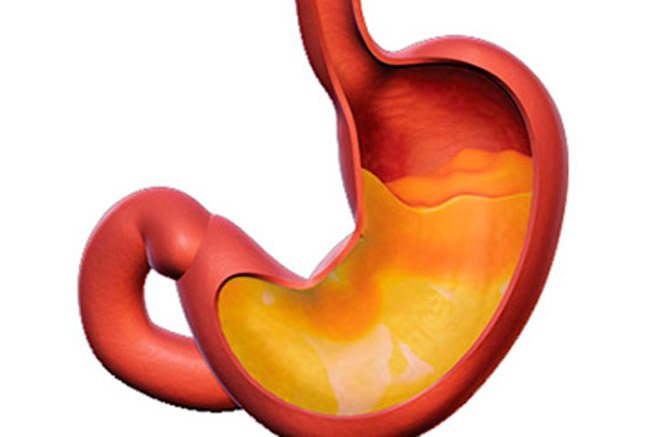
Irritation of the stomach walls with acid or food, an acute inflammatory process, back waves and reflux of contents into the esophagus - this is what provokes nausea, which ends with vomiting.
Often the appearance of unpleasant symptoms occurs due to infection. Viruses and bacteria are pathogens that affect the gastrointestinal tract. They enter the body with food, water, are carried with dirty hands, and a few are even transmitted by airborne droplets. With these diseases, a person feels sick and then vomits. After the stomach is empty, temporary relief occurs.
Also, the causes of discomfort may be the following:
- neurological diseases (brain injury and infection, migraine, tumors);
- disturbances in the functioning of the cardiovascular system (hypertension, heart attack, functional failure);
- pathologies of the endocrine system (diabetes, thyrotoxicosis, phenylketonuria);
- psychological (fear, panic attack);
- vestibular (sea sickness).
Onset of symptoms
Before vomiting begins, a person experiences a number of symptoms. In most cases, they are similar and do not depend on the cause of discomfort. Nausea begins with the so-called “sucking in the pit of the stomach.” The patient feels hot and cold sweats appear. Pulse and blood pressure become higher at this moment. Rapid breathing and profuse salivation are accompanied by gagging.
Interesting! Function, composition and properties of gastric juice - how it is formed

Vomiting occurs when the contents of the stomach are expelled through the esophagus. It is impossible to stop this process or restrain the urges. The masses may have a sour, unpleasant odor, be accompanied by the release of blood, putrefactive impurities, or be watery. In case of poisoning and gastric pathologies, an eruption of undigested food is observed.

